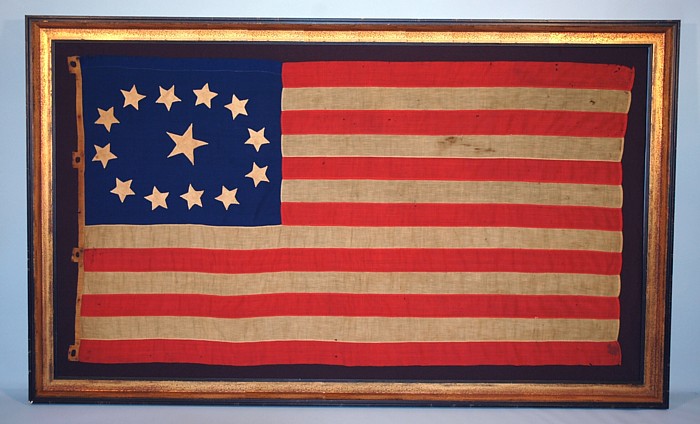
| |
13 STARS, CIRCA 1860, SIGNED CHAS. E. DUBOIS, OVAL 3RD MARYLAND PATTERN |
|
| Available: |
Sold |
| Frame Size (H x L): |
49.5" x 82" |
| Flag Size (H x L): |
39" x 71.5" |
|
| Description....: |
|
| 13 STARS, CIRCA 1860, SIGNED CHAS. E. DUBOIS,
OVAL VARIATION OF THE 3RD MARYLAND DESIGN:
13 star American national flag made in 1860, one year before the Civil War. This was a time of great unrest and anxious anticipation of the forthcoming likelihood of war between the states. It was also the year that Lincoln gained the Whitehouse and a time of rapidly growing patriotism. Despite these facts, surviving examples of flags that date to this particular year are seldom seen. The 33 star flag was official from 1859-1861, yet 33 star flags, especially those with sewn construction (as opposed to printed), are extremely rare. By the middle of the following year, the 34th state had been added, the war had begun, and flags were produced by the thousands.
The configuration of this flag, with its oval wreath of small stars, surrounding a much larger center star, is generally referred to as the 3rd Maryland pattern. This design is often referred to as the 3rd Maryland pattern and is very desirable due to the scarcity of its use. The name comes from a flag that was thought to have been present with General Daniel Morgan, carried by Color Sergeant William Batchelor of the Maryland Light Infantry at the battle of Cowpens in 1781. The Cowpens flag, which now resides at the state capital in Annapolis, was later discovered to be of Mexican War origin (1846-48) at the earliest. A similar flag, in the collection of the Smithsonian?s National Museum of History & Technology, was carried by the Maryland and District of Columbia Battalion of Volunteers during the Mexican War.
Written along the sleeve of the flag, very faint but legible, is the name ?Chas. E. DuBois? and the date ?1860?. The overall state of preservation suggests that it was seldom flown, and likely made as a presentation gift, or to be flown for one specific event, such as the presidential election.
The flag is entirely hand-sewn. Its stars, which are made of cotton, are single applique This means that they were appliqued on one side of the canton, then the blue fabric was cut from behind each star, folded over, and sewn to make one appliqued star visible on both sides of the flag. This almost always results in more irregular, folky, and otherwise interesting stars. The canton and stripes of the flag are made of a cotton and wool blend or a very fine wool. This fabric is quite often seen in the cantons of Civil War-era flags, but is almost never seen in the stripes. The hand-sewing is of exceptional quality. The twill cotton hoist is very unusual because of the reinforced tabs surrounding its four whip-stitched grommets. Inside the tabs, for added strength, are small scraps of blue and white gingham plaid homespun.
13 star flags have been used throughout our Nation?s history for a variety of purposes. The U.S. Navy used the 13 star count on small boats, not only in the 18th century, but throughout much or all of the 19th century. The practice ended in 1916 following an executive order from President Woodrow Wilson. Some private ships also used 13 star flags during the same period as the Navy, and the use of yachting ensigns with a wreath of 13 stars surrounding an anchor still persists today. Among other uses, 13 star flags were carried by soldiers during the Mexican and Civil Wars, and were used at patriotic events, including Layfayette?s visit in 1825-26, the celebration of the Nation?s Centennial in 1876, and the Sesquicentennial in 1926.
Mounting & Condition: Please call for details. |
|
|
|
| Collector Level: |
|
|
| Flag Type: |
Sewn flag |
|
| Star Count: |
13 |
|
| Earliest Date of Origin: |
1860 |
|
| Latest Date of Origin: |
1860 |
|
| State/Affiliation: |
13 Original Colonies |
|
| War Association: |
1777-1860 Pre-Civil War |
|
| Price: |
No |
|
| |
Views: 3056 |
|
|
|

